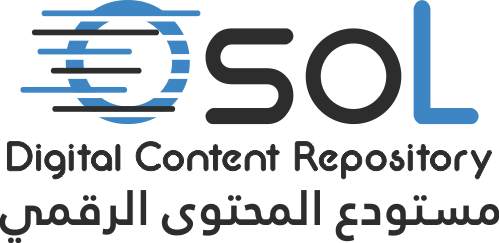Please use this identifier to cite or link to this item:
https://dspace.qou.edu/handle/194/2913Full metadata record
| DC Field | Value | Language |
|---|---|---|
| dc.contributor.author | Abdullah, Wafa | - |
| dc.contributor.author | Abdel Qader, Dr. Husain | - |
| dc.date.accessioned | 2025-08-26T08:58:05Z | - |
| dc.date.available | 2025-08-26T08:58:05Z | - |
| dc.date.issued | 2025-04-06 | - |
| dc.identifier.uri | https://dspace.qou.edu/handle/194/2913 | - |
| dc.description.abstract | The study aimed to explore the strategic intelligence in the relationship between strategic leadership and administrative creativity in the Palestinian Ministry of Education and Higher Education. To achieve this, the researcher employed a descriptive-analytical approach, which was deemed most suitable for this study. A questionnaire was used as the primary tool for data collection. The study population consisted of 870 employees in the Palestinian Ministry of Education and Higher Education. The researcher utilized a purposive sampling method for employees at the ministry's headquarters in Ramallah, comprising 270 employees. The data were analyzed using the Statistical Package for Social Sciences (SPSS). The results showed that the arithmetic mean of the study sample's estimates for strategic intelligence, encompassing dimensions such as forecasting, strategic vision, and motivation, was 60.5%, indicating a moderate level. Regarding strategic leadership, the dimensions of strategic orientation, human capital, organizational culture, and organizational control had a combined mean of 64.25%, also indicating a moderate level. The elements of administrative creativity, including fluency, flexibility, originality, and problem sensitivity, had a mean of 59.6%, again indicating a moderate level. While the hypothesis results showed a statistically significant effect at the significance level (α > 0.05) for strategic intelligence as a mediating variable in enhancing the relationship between strategic leadership and administrative innovation in the Palestinian Ministry of Higher Education, the provided search results do not explicitly address this specific context or statistical outcome. The researcher provided several recommendations, including: The Ministry of Education and Higher Education should show concern for future predictions of any risk, such as wars and pandemics like diseases. Work on having a strategic vision based on strategic intelligence within the Ministry of Education and Higher Education Utilize strategic intelligence to develop an achievable strategic vision while working at the Ministry of Education and Higher Education, by creating feasible plans and alternative plans during emergencies and disasters. Support the Ministry of Education and Higher Education employees to find motivation in applying strategic intelligence in their workflow through courses, seminars, and employee-specific meetings. | en |
| dc.publisher | Qou | en |
| dc.subject | الذكاء الاستراتيجي | en |
| dc.subject | Strategic Intelligence | en |
| dc.subject | القيادة الاستراتيجية | en |
| dc.subject | الإبداع الإداري | en |
| dc.subject | وزارة التربية والتعليم العالي الفلسطينية | en |
| dc.subject | Strategic Leadership | en |
| dc.subject | Palestinian Ministry of Education | en |
| dc.subject | Administrative Creativity | en |
| dc.title | The Mediating Role of Strategic Intelligence in the Relationship Between Strategic Leadership and Administrative Creativity in the Palestinian Ministry of Education and Higher Education | en |
| dc.type | Thesis | en |
| dc.description.arAbstract | هدفت الدراسة التعرف إلى الذكاء الاستراتيجي في العلاقة بين القيادة الاستراتيجية، والإبداع الإداري في وزارة التربية والتعليم العالي الفلسطينية، وبناء عليه استخدمت الباحثة المنهج الوصفي التحليلي كونه المنهج الأنسب لهذه الدراسة، ثم استخدمت الاستبانة كأداة للدراسة، مجتمع الدراسة الذي تكون من (870 ) موظفة، وموظفاً في وزارة التربية والتعليم العالي الفلسطينية. استخدامت أسلوب العينة المتيسرة للعاملين في مقر\ وزارة التربية والتعليم العالي الفلسطينية في رام الله مكونه من (270) موظفة، وموظفاً، التي تم تحليل بياناتهما من خلال برنامج التحليل الإحصائي ((SPSS . أظهرت التنائج أن المتوسط الحسابي لتقديرات العينة الدراسة للذكاء الاستراتيجي مجموع بأبعاده، وهي (الاستشراف، والرؤية الاستراتيجية، والدافعية) حيث بلغت (60.5%) بمستوى متوسط، فيما يتعلق بواقع القيادة الاستراتيجية مجموع أبعاده (التوجه الاستراتيجي، ورأس المال البشري، والثقافة التنظيمية، والرقابة التنظيمية) حيث بلغت (64.25) بمستوى متوسط عناصر الإبداع الإداري (الطلاقة، المرونة، الأصالة، الحساسية للمشكلات) حيث بلغت (59.6) بمستوى متوسط . في حين كانت نتائج الفرضيات يوجد أثر ذو دلالة احصائية عند مستوى الدلالة (0.05> a) للذكاء الاستراتيجي في تعزيز العلاقة بين القيادة الاستراتيجية، وتحقيق الإبداع الإداري في وزارة التربية والتعليم العالي الفلسطينية. وأن أهم التوصيات كانت: أن تبدي وزارة التربية والتعليم العالي أهتماما بالتنبؤات المستقبلية لأي خطر، مثل الحروب، والجائحات كالامراض.العمل على وجود رؤية استراتيجية قائمة على الذكاء الاستراتيجي في، وزارة التربية، والتعليم العالي.استخدام الذكاء الاستراتيجي في عمل رؤيا استراتيجية قابلة للتحقيق أثناء العمل في وزارة التربية والتعليم العالي، بعمل خطط قابلة للتحقيق، وخطط بديلة أثناء الطواريء، والكوارث. دعم وزارة التربية والتعليم العالي للموظفين لإيجاد الدافعية لدى الموظف في تطبيق الذكاء الاستراتيجي في سير العمل . من خلال الدورات، والندوات، واللقاءات الخاصة بالموظفين. | en |
| dc.contributor.arAuthor | رشدي عبد الله, وفاء عبد الخالق | - |
| dc.contributor.arAuthor | عبد القادر, د. حسين | - |
| dc.arTitle | الدور الوسيط للذكاء الاستراتيجي في العلاقة بين القيادة الاستراتيجية، والإبداع الإداري في وزارة التربية والتعليم العالي الفلسطينية | en |
| Appears in Collections: | Strategic Leadership and Management - القيادة والإدارة الاستراتيجية | |
Files in This Item:
| File | Description | Size | Format | |
|---|---|---|---|---|
| رسالة ماجستير وفاء عبد الله مدققة.pdf | 3.45 MB | Adobe PDF | View/Open |
Items in DSpace are protected by copyright, with all rights reserved, unless otherwise indicated.
